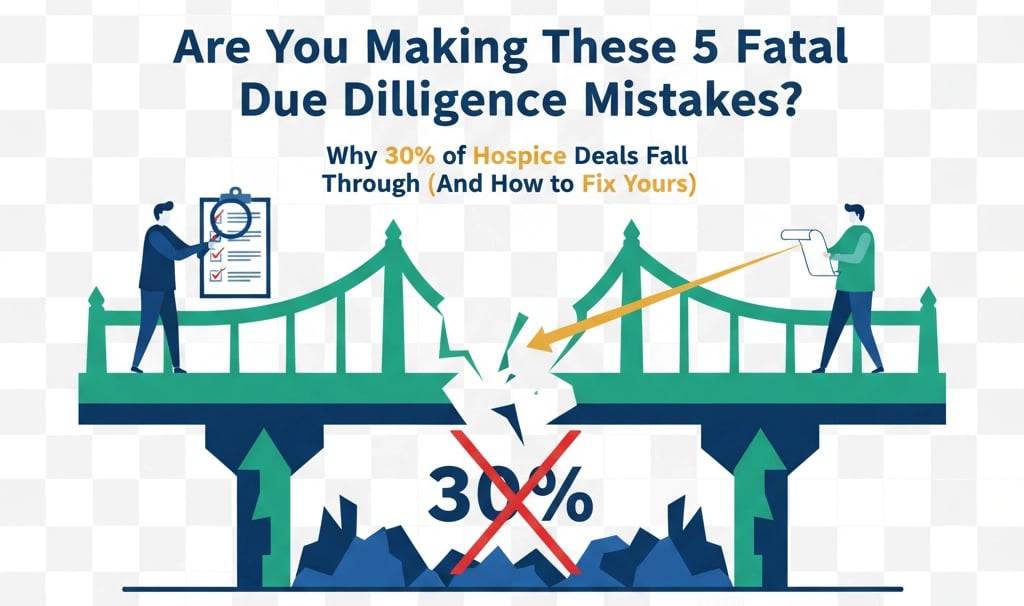Are You Making These 5 Fatal Due Diligence Mistakes? Why 30% of Hospice Deals Fall Through (And How to Fix Yours)
This comprehensive guide examines the five most critical due diligence mistakes that cause hospice M&A deals to collapse, providing actionable strategies to protect your transaction and maximize your agency's exit value.
10/16/20256 min read


The hospice M&A market remains active despite increasing scrutiny from buyers and regulators. While exact failure rates vary, industry experts consistently identify specific due diligence pitfalls that can derail even well-negotiated transactions. Understanding these common mistakes and implementing preventive measures can mean the difference between a successful exit and a collapsed deal that costs months of preparation and potential buyer relationships.
Mistake #1: Billing and Coding Compliance Failures
High error rates in billing and coding audits represent one of the most devastating deal-killers in hospice transactions. Buyers conducting diligence phase audits will likely abandon a sale if they discover significant discrepancies or high error rates that could jeopardize hospice eligibility.
The scrutiny centers on whether the seller properly documents, substantiates, and verifies all necessary elements for Medicare payment of hospice services. These audits examine specific compliance requirements including appropriate physician signatures, mandatory patient disclosures, and proper certification documentation.


Technical findings around the certification of terminal illness (CTI) pose particular risk. The CTI requires two physician signatures when an attending physician is elected by the beneficiary, and must be signed within strict timeframes - no more than 15 days prior or within 2 days of the recertification date.
Missing or inadequate clinical documentation that supports eligibility at admission and recertification can halt deals immediately. Visit assessments and notes must provide comparative data such as changes in activities of daily living, decline in weight or Body Mass Index (BMI), and palliative performance scores (PPS) less than 60%.
How to Fix It: Conduct comprehensive pre-sale compliance audits to identify and remediate billing, coding, and documentation issues before engaging with buyers. This allows you to enter negotiations with confidence and avoid costly surprises during formal due diligence.
Mistake #2: Hospice Cap Liability Complications
Hospice cap liability creates complex negotiation challenges that buyers and sellers often cannot resolve. Buyers must assess where the seller stands relative to annual cap calculations and what liability trends indicate for the future.
The difficulty arises when sellers, even if they recognize potential responsibility for exceeding the hospice cap, worry that the liability could grow larger due to factors outside their control after closing. When parties cannot reach agreement on who bears responsibility for potential cap overpayments, or when buyers determine the exposure is too large or uncertain, transactions frequently stall.


This disagreement represents a fundamental meeting-of-the-minds problem that proves difficult to overcome through standard deal structuring. Many experienced buyers will simply walk away rather than inherit unknown cap liability exposure.
How to Fix It: Address hospice cap liability proactively by calculating potential exposure and developing a reasonable allocation strategy before negotiations begin. Having concrete data and a proposed solution prevents this issue from becoming an insurmountable obstacle. Consider working with experienced advisors who understand healthcare partnership consultation strategies.
Mistake #3: Poor Financial Recordkeeping and Documentation
Poor financial recordkeeping stands as a primary reason deals collapse across all industries, and hospice is no exception. Organizations with disorganized or incomplete financial records raise immediate red flags during due diligence, causing buyers to question what other problems might exist beneath the surface.
Negative changes in business performance during the due diligence period can similarly derail transactions. When a key employee leaves, the organization loses its largest referral source, or census unexpectedly declines, buyers legitimately reconsider the valuation and viability of the deal.


Common financial recordkeeping failures include:
Incomplete or inconsistent revenue tracking
Missing expense documentation
Unclear accounts receivable aging
Inadequate payroll records
Poor cash flow documentation
Missing tax returns or financial statements
How to Fix It: Organize and verify financial records well in advance of any transaction discussions. Ensure all revenue, expenses, and balance sheet items can be clearly traced and substantiated. Consider engaging a qualified CPA to review your books before entering the market.
Mistake #4: Technology and Documentation System Deficiencies
Hospices using outdated forms or misusing electronic medical record (EMR) systems often fail to capture information required by Medicare for admissions. Both paper and electronic forms require regular review to ensure they contain proper verbiage regarding start of care and identification of attending or ordering physicians.
When due diligence reveals systematic documentation failures stemming from technology deficiencies, buyers face the prospect of inheriting significant compliance remediation costs. This can quickly eliminate any projected return on investment.


Technology-related red flags include:
Outdated EMR systems that don't capture required Medicare elements
Inconsistent documentation across different platforms
Missing integration between clinical and billing systems
Poor data backup and security protocols
Inadequate reporting capabilities for regulatory requirements
How to Fix It: Update technology and documentation systems to ensure EMR platforms capture all required Medicare elements. Review and revise clinical forms to meet current regulatory requirements. Investment in modern systems before a sale can significantly increase your agency's valuation and attractiveness to buyers.
Mistake #5: Lack of Transparency and Undisclosed Facts
Unforeseen or undisclosed facts discovered during due diligence frequently end transactions. The temptation to hide problems or present an overly optimistic view of the business often backfires spectacularly when buyers uncover the truth during their investigation.
Common undisclosed issues that derail deals include:
Pending regulatory investigations or compliance issues
Key employee departures or retention problems
Major referral source instability
Hidden liabilities or contingent obligations
Disputes with regulatory bodies or payers


The discovery of undisclosed facts not only kills the current deal but can damage your reputation in the market, making it harder to find future buyers. Word travels quickly in the hospice industry, and buyers talk to each other.
How to Fix It: The best defense against losing a buyer involves complete transparency during initial discussions about the business. Any issues likely to surface during due diligence should be addressed proactively, allowing your advisor to control how information is presented rather than managing damage control after discovery.
Building a Bulletproof Due Diligence Strategy
Successfully navigating hospice M&A requires more than avoiding common mistakes. It demands a comprehensive strategy that positions your agency as an attractive, low-risk acquisition target.
Maintain clinical documentation discipline throughout your organization, ensuring interdisciplinary group notes, visit assessments, and eligibility documentation consistently provide the comparative data and detail necessary to withstand scrutiny. This ongoing attention to detail pays dividends when buyers review your operations.
Consider the current market dynamics affecting hospice agencies. With reimbursement and regulatory updates impacting agency value, buyers are increasingly selective about their acquisitions. Agencies that demonstrate strong compliance records and operational excellence command premium valuations.
Engage experienced M&A advisors who specialize in hospice transactions. These professionals can properly screen buyers, control the due diligence process, and negotiate effectively on your behalf. The right advisor helps present challenges in context rather than allowing them to become deal-breakers.
For owners considering an exit, succession planning as a strategic advantage becomes critical. Starting your preparation 12-24 months before entering the market allows time to address potential issues and optimize your agency's presentation to buyers.
The Path Forward
The hospice M&A landscape remains active despite slower transaction volume in recent periods. Deals are harder to close than in prior years, but strong M&A activity and owner-operator models continue to create opportunities for well-prepared sellers.
Organizations that address compliance vulnerabilities and operational weaknesses before entering the market position themselves for successful transactions at optimal valuations. The key lies in understanding what buyers scrutinize most intensely and proactively addressing those areas.
By avoiding these five fatal due diligence mistakes and implementing the recommended solutions, hospice owners can significantly improve their chances of achieving a successful exit. The investment in proper preparation pays dividends through higher valuations, smoother transactions, and preserved buyer relationships that benefit the entire industry.
Remember that due diligence works both ways. While buyers evaluate your agency, you should also be evaluating them as potential partners who will carry forward your legacy of patient care and employee stewardship.
Unlock Your 30-Minute Agency Succession Review
Maybe you're ready to expand your reach, or perhaps it's time to consider your legacy and the future of your business. Either way, it all begins with a conversation. Schedule a confidential, no-obligation call to explore what the future might hold for you and your business.
Complete the form, and we'll reach out for a chat...


© 2025 SENATE HEALTHCARE LLC.
ALL RIGHTS RESERVED


